![]()
![]()
![]()
Use LEFT and RIGHT arrow keys to navigate between flashcards;
Use UP and DOWN arrow keys to flip the card;
H to show hint;
A reads text to speech;
91 Cards in this Set
- Front
- Back
|
Health (WHO 1946) |
A state of complete physical, mental and social wellbeing and not merely the absence of disease or infirmity |
|
|
Health (WHO 1984) |
The extent to which an individual or group is able to realize aspirations and satisfy needs, and to change or cope with the environment; health is a resource for everyday life, not an objective of living; it is a positive concept, emphasizing social and personal resources as well as physical capabilities |
|
|
Acute illness |
A disease with an abrupt or rapid onset and usually a short duration (e.g., infection; exacerbation of symptoms associated with chronic conditions) |
|
|
Chronic illness |
A health condition that is long-lasting (typically, exists for 6 months or longer) and needs to be managed on a long-term basis (e.g., diabetes, arthritis) |
|
|
Terminal illness |
An active and progressive disease with no reasonable chance of cure (e.g., advanced cancer, Amyotrophic Lateral Sclerosis) |
|
|
Disease |
Based on a medical diagnosis which locates a problem in specific organs or boxy systems, and is treated through biomedical treatments |
|
|
Illness |
The subjective/personal experience of a disease state or a person who acknowledges s(he) does not feel well |
|
|
Sickness |
The social actions taken by a person as a result of an illness or a disease (e.g., taking medication, visiting doctor, resting) |
|
|
Disability |
The Canadian Survey on Disability (CDS) uses the World Health Organization's International Classification of Functioning Disability and Health framework of disability. This framework defines disability as the relationship between body function and structure, daily activities and social participation, while recognizing the role of environmental factors. In keeping with this framework, the CDS targeted respondents who not only have difficulty with impairment due to a long-term condition or health problem but also experience a limitation in their daily activities. The CDS definition of diabolic includes anyone who reported being "sometimes", "often" or "always" limited in their daily activities due to a long-term condition or health problem as well as anyone who reported being "rarely" limited if they also unable to do certain tasks or could only do them with a lot of difficulty |
|
|
Older adults have at least _______ chronic disease or health-care problems by the time they reach 65 years of age |
3 |
|
|
Which chronic disease occur most frequently? |
Arthritis Heart conditions (hypertension) Sensory changes |
|
|
Prevalence of most types if disability increase with age (e.g., mobility, agility, hearing, seeing, pain, memory and speech) BUT .... |
This pattern is not seen with all disabilities |
|
|
Most common combination of multiple disabilities in older persons is..... |
Pain, flexibility, and mobility disabilities |
|
|
Older _________ tend to report higher disability rates than ______, and have higher rates of chronic conditions |
Women Men |
|
|
Cardiovascular Conditions (Coronary Artery Disease, Congestive Hearth Failure, Peripheral Vascular Disease) |
-heart attack is one of the leading causes of death and disability in older adults -mortality rate for persons older than 70 is about twice the rate of younger individuals -many persons older than 65 experience hypertension -may lead to edema (swelling) in feet and legs -risk factors include smoking, obesity, hypertension, etc |
|
|
Neurological Conditions (Cerebrovascular Accident, Parkinsons Disease, Sensory Losses) |
-stroke is one of the leading causes of death and disability in older adults -disabilities may include motor abilities, memory, language, communication, visual - perception, etc - two common physical complications of CVAs : contractures and skin breakdown (pressure sores) -visual and hearing losses begin around 50 years of age - risk factors include advanced age, hypertension, diabetes, heart disease, etc |
|
|
Cardiovascular disease (Statistics Canada, 2011) |
Defines as diseases and injuries of the cardiovascular system: the heart, the blood vessels of the heart and the system of blood vessels (veins and arteries) throughout the body and within the brain. Stroke is the result of a blood flow problem in the brain. It is considered a form of cardiovascular disease. |
|
|
Since 1952, the cardiovascular death rate in Canada has declined by more than ______ - and nearly ______ in the last decade |
65% 40% |
|
|
The cardiovascular death rate has declined largely due... |
To research advances in surgical procedures, drug therapies and prevention efforts |
|
|
Canada : every _____ minutes someone dies from heart disease or stroke |
7 |
|
|
Canada 2008: Cardiovascular disease accounted for _______ of all deaths |
29% |
|
|
Musculoskeletal Conditions (Osteoarthritis, Degenerative Joint Disease, Osteoporosis) |
-may experience of joint stiffness, muscle aches, decreased bone mass, etc -greater risk of mobility issues, fractures |
|
|
Pulmonary Conditions (Chronic Obstructive Pulmonary Disease, Asthma) |
-signs and symptoms include cough, shortness of breath |
|
|
Metabolic and Endocrine Conditions (Type II Diabetes) |
-complications may include skin lesions, renal problems, feet-related issues, eye problems |
|
|
Dementia |
Group of symptoms affecting mental processes,thinking, reasoning, and social abilities severely enough to interfere with daily functioning; indicates problems with at least two brain functions (e.g., memory loss + impaired judgment or language, inability to perform some daily activities) |
|
|
Alzheimer's Disease |
The most common cause of dementia; progressive disease where the connections between brain cells and the brain cells themselves degenerate and die, causing a steady decline in destruction of memory and mental function |
|
|
Biopsychosocial approach of disability |
Based on the integration of two opposing models (medical and social) to represent a more holistic view of health from a biological, individual and social perspective |
|
|
Sedentary life ______ disability risk in seniors |
Doubles |
|
|
________ million adult Canadians (aged 15 years or older) reported being limited in their daily activities due to a disability in 2012 |
3.8 million (represents 13.7% of the adult population) |
|
|
Population with a disability , 2012 |
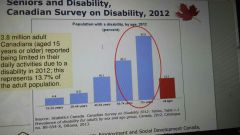
|
|
|
Prevalence of disability by sex and age group,Canada 2012 |
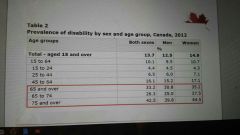
|
|
|
Population with a disability by gender and age, 2012 |
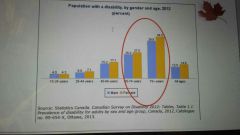
|
|
|
Population with a disability by region, 2012 |
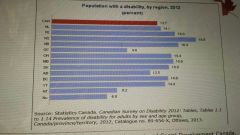
|
|
|
Pulmonary system |
Respiratory infections, difficulty breathing, shortness of breath |
|
|
Cardiovascular system |
Hypertension Irregular heartbeat |
|
|
Gastrointestinal system |
Stomach discomfort Nausea Vomiting Bowel movements |
|
|
Musculoskeletal system |
Discomfort in joints Muscle cramps Weakness of arms/legs Problem with mobility |
|
|
Genitourinary system |
Urinary incontinence Burning when urinating |
|
|
Neurological system |
Fainting Dizziness Unsteady gait |
|
|
Endocrine system |
Increased in thirst Dry skin Intolerance to heat or cold |
|
|
Self reporting functional capacity limitation, by age group, Canada, 2008-2009 |
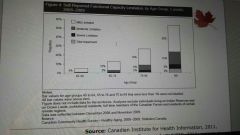
|
|
|
Psychosocial factors impacting management of chronic health conditions |
-stressor about daily life (e.g., uncertainty about relocation) -anxiety about treatments and course of treatment (or rushing treatments) -lack or support and resources to manage conditions (e.g., social and financial) -inability to cope with long-term aspects of condition -feeling discouraged, restricting activity, and becoming deconditioned -low health literacy to effectively deal with condition (e.g., comprehension, access to services, and use of resources) |
|
|
Functional health |
Ability to take care of self-care tasks and personal needs of everyday life (e.g., BADLs, IADLs, mobility cognition, safety) |
|
|
Preventive healthcare and health promotion |
Programs designed to optimize health, stop health problems before they occur, promote positive health behaviours, and intervene in illness to slow down the impact of disease and functional losses; self-efficacy and self-regulation |
|
|
Quality of life |
Overarching, general construct to understand ones perspective about his or her well-being and life satisfaction, includes a number of domains such as optimal health, independence, environment, physical health, social well-being, psychological well-being, etc |
|
|
Quality of life (Last, 2007) |
An essentially subjective judgement of the way people perceive themselves as content and happy or otherwise, and able to function physically, emotionally, and socially. Others, including health workers, can make a relatively objective judgement of some of these aspects of a person's way of living, but the affected individual is the ultimate judge |
|
|
Defining feature of Canada is the publicly funded healthcare system which... |
Guarantees universal coverage for medically necessary hospital and physician services that are provided on the basis of need |
|
|
The ___________, ___________, and ________have key roles to play in the healthcare system |
Federal government Ten provinces Three territories |
|
|
Health care Federal government responsibilities : Provincial/ territorial responsibilities: |
Federal government provides funding through cash and tax transfers to the provinces and territories to help pay for the healthcare services, but the delivery if services is a provincial/territorial responsibility |
|
|
Federal government is directly (financially) responsible for specific populations, such as.... |
First Nations and Inuit; Canadian Forces and RCMP; inmates of federal prisons) |
|
|
Canada Health Act (CHA) 1984 -principles of medicare |
Comprehensive Universality Portability Accessibility Public Administration |
|
|
Medicare _ Comprehensive |
Health care insurance plan of a province must include all services that are medically necessary |
|
|
Medicare _ Universality |
Demand that all residents in the province have access to public healthcare insurances and insured services on uniform terms and conditions |
|
|
Medicare _ Portability |
Requires provinces to cover insured health services provided to their residents while they ate temporarily absent from their province of residence or from Canada; for insured health services provided in another province, payment is safe at the rate negotiated by the government of the two provinces |
|
|
Medicare _ Accessibility |
Insured persons must have reasonable and uniform access to insured health services, free of financial or other barriers (no co-payments, deductibles, or annual limits); No one may be discriminated against on the basis of income, age, health status, etc |
|
|
Medicare _ Public Administration |
Each provincial healthcare insurance plan must be administered on a non-profit basis by a public authority |
|
|
Ministry of Health and Long term care |
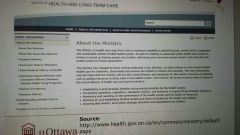
|
|
|
Local Health Integration Networks (LHINs) |
Ontario created 14 LHINs in 2006, with the mandate to plan,fund and integrate health services for more efficient care in their regions |
|
|
In many provinces, authority and governance of health care has been moved to regional authorities, based on the belief that,... |
Local authorities can better integrate and coordinate services, and contain costs |
|
|
Health authorities are responsible for ... |
Regional administration of public health care services |
|
|
Seniors may have to sign over _______ of their income to local health authorities once they are admitted to a long-term care institution |
~70% |
|
|
LHINs are.... |
Community based, non-profit organization funded by the Ministry of Health and Long Term Care |
|
|
Total health expenditure by use of funds, Canada, 2012 |
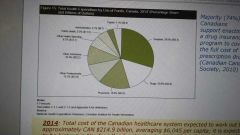
|
|
|
________ of Canadians support enacting a drug insurance program to cover the full cost of prescription drug |
Majority (74%) |
|
|
2014: Total cost of the Canadian Healthcare system expected to work out to approximately ________, averaging __________ per capita;it is expected to be highest in Newfoundland and Labrador ($6 953) and Alberta ($6 783), and lowest in Quebec ($5 616) and British Columbia ($5 865) |
CAN $214.9 billion $6 045 |
|
|
Important health benefits programs in Ontario |
Ontario Drug Benefit Program (ODB) Assistance Devices Program (ADP) Community-Care Access Centres (CCAC) and Home Care Services |
|
|
Ontario Drug Benefit Program and Seniors - eligibility |
Live in Ontario, have an Ontario health card, and are 65 years of age or older - also may eligible for other reasons (e.g., live in long-term care home, have high drug costs relative to income, receive social assistance through ODSP) |
|
|
Ontario Drug Benefit Program and Seniors - to claim benefits |
Take pescription and health card to pharmacy, and inform them that you are eligible for the ODB. ODB pays most of the cost of approved prescription products |
|
|
Ontario Drug Benefit Program and Seniors - cost to seniors |
Most seniors will pay the first $100 of their prescription drug costs at the pharmacy (the "deductible"). Deductible is paid by purchasing approved prescription products as a drug store. Once the deductible is paid, most seniors will then be asked to pay up to $6.11 for each approved prescription filled (the "co-payment") |
|
|
Asistance Devices Program - aim |
To provide support and funding to Ontarians who have long-term physical disabilities, and to process access to personalized assistive devices to meet their basic needs and increase their independence |
|
|
Assistance Devices Program - equipment/supplies |
Covers 8 000+ items (e.g., mobility, aids,wheelchairs, hearing aids, respiratory equipment, etc) |
|
|
Assistive Devices Program - eligibility |
Ontario health card, physical disability of 6 months+, equipment not exclusively for sports, work, school |
|
|
Assistance Devices Program - Financial assistance |
Pays up to 75% of equipment cost (e.g., wheelchairs); for other devices (e.g., hearing aids), contributes a fixed amount; for some supplies (e.g., needles), pays a grant directly to the person; for Home Oxygen Program, pays 100% of price for oxygen/related equipment for those aged 65+ AND for those aged 64 or younger who are on social assistance, residing in a long-term care facility, or who receive services through CCAC, and 75% of cost for all other person |
|
|
Community Care Access Centre's (CCAC) and Home Care Services |
-home care programs across Canada aim to provide both health and social support services to clients in need of assistance to remain at "home or in the community" -in Ontario, publicly funded home care services are coordinated by Community Care Access Centre's (CCAC) which are publicly funded agencies that provide information about care options. The CCACs were established by the Ministry of Health and Long-Term Care in 1996 -in addition to government funded care, people wanting to stay at home may access services by purchasing services privately or accessing private insurance or benefit plans |
|
|
Ontario Disability Support Program (ODSP) |
Helps people with disabilities who are in financial need to pay for living expenses (e.g., food and housing) |
|
|
Ontario Disability Support Program -eligibility |
18+ years of age, live in Ontario, in financial need, and have substantial physical or mental disability that:is expected to last a year or linger and makes it hard to care for oneself and take part in community life or work |
|
|
Ontario Disability Support program provides eligible people with disabilities with __________ and _________ |
Income support (financial help): helps people with disabilities who are in financial need to pay for living expenses Employment support (help finding a job): helps people with disabilities who can and want to work prepare for and find a job |
|
|
An applicant who qualifies financially for ODSP needs to go through a disability determination process to determine if he or she is a person with a disability, as defined under the ODSP Act, unless they are a ___________ |
Member of a prescribed class |
|
|
ODSP applicant aged+ years AND not receiving OAS |
Person is considered a member of a prescribed class; thus, the person is not required to go through the disability determination process and may receive ODSP income support and benefits if financially eligible |
|
|
ODSP applicant aged 65+ years and AND is receiving OAS |
Person needs to be found financially eligible and go through the disability determination process to determine if he or she is a person with a disability, as defined under the ODSP Act to be eligible for ODSP income support and benefits |
|
|
Falls are a major source of physical dysfunction and mortality among the elderly and physically disabled. Falls often occur during ________ |
ADLs |
|
|
Falls account for more than ____ if all injuries among seniors |
Half |
|
|
_______ of community-residing seniors experience at least 1 fall/year |
1/3 |
|
|
_______ of deaths related to injury can be traced to a fall |
20% |
|
|
Falls account for ____ if all hospitals admissions and ______ of seniors injury - related hospitalizations |
34% 85% |
|
|
____ of falls result in hip fractures |
40% |
|
|
________ older adults will die within 12 months of suffering a hip fracture |
1 in 5 |
|
|
Falls are responsible for ______ of admissions to nursing homes |
40% |
|
|
Fall prevention interventions may include: |
1. Home safety assessment and modifications (e.g., securing rugs and electrical cords, removing clutter, installing hand rails and grab bars) 2. Improving intrinsic factors (e.g., balance, stamina, gait, energy conservation techniques, fear/ axiety) 3. Safe use of mobility aids (e.g., brakes on walkers) 4. Medical assessment (e.g., medications, dizziness) 5. Community - or hospital - based fall prevention programs 6. Relocating to an alternative setting |
|
|
Phillips Lifeline |
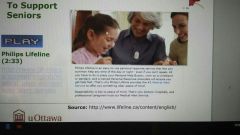
|
|
|
Medical alert service |
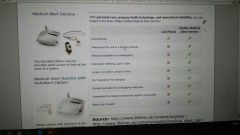
|

